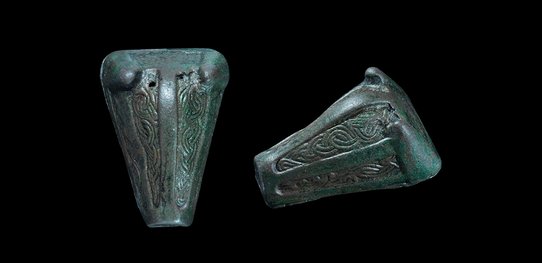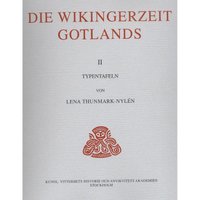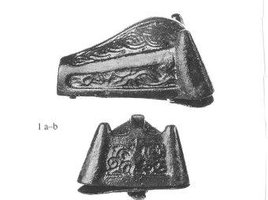Viking boar head brooch.
Viking 'boar' brooch with interlaced panels
10th century AD
A bronze boar-head brooch with separate backplate; the body formed as a hollow-cast case with upstanding ears and raised bar to the muzzle separating two panels of three-strand interlace ornament; to the sides and top, panels of scrolled tendrils; backplate attached by five studs, with rectangular slot, pin-lugs, round-section pin and integral catchplate; hole to the brow between the ears to attach a chain, small casting flaw to nasal. 66 grams, length 55mm (2 1/4").
Its width is 38 mm at the broadest part (the 'ears' part) 38 mm and 23 mm at the smallest broadest part (the 'nose'). Its height is app. 25, 26 mm. Weight: 66.05 grams.
Very fine condition.
The form of boar-head brooch with a separately-cast backplate is introduced around 900 AD. Many examples have been pierced to accept an attachment chain from which utensils could be hung in an ostentatious manner. (text from the auction catalogue from Timeline Auctions May 2015).
Anders Carlsson, author of the book 'Djurhuvudformiga spännen och gotländsk vikingatid: Text och katalog (Stockholm studies in archaeology)' wrote to me:
'Your animal head brooch is type 5.4., period C, 10th Century. There are 48 of them on Gotland, mainly with rivetted base-plates.
Translation: brooches with animal ornamentation or geometrical design originating from animal ornaments, covering the whole surface. The ornamentation is divided in four fields, separated by a frame-work. The front has ornamentation originating in two birds, crossing each other'
An image of this type 5.4 can be found on page 48 of his book and I added a photo of that page below).
This specific kind of brooch is also published in Thunmark-Nyléns Die Wikingerzeit Gotlands, II. Typentafeln. 1998
Tafel 22, Picture 1 a-b.
Anders Carlsson also wrote to me:
'... I looked in Thunmark-Nyléns Die Wikingerzeit Gotlands, II. Typentafeln. 1998. Tafel 22, Picture 1 a-b.
There is a brooch exactly like yours, with rivetted base-plate and all, from Norrgårde in Hellvi parish on Gotland. It´s kept in the museum in Visby, GF A 3016. In my book it is number 46.36 on page 193. You can check the measurments to yours! It was found in a field in 1882. Perhaps they belong together! Se if the measurements are the same!'
The measurements of the brooch of from Norrgårde in Hellvi parish on Gotland is 54 mm in length, width 39,5 mm and height ca 22 mm.
Making it possible - considering Anders Carlsson that 'If the farmer "secretly" sold a brooch in 1882 and handed in another to the museum (when told to do so), one brooch could have reached the market - why not?'
See also the blog on animal-head shaped brooch, also more in general:
Viking jewellry from the isle of Gotland - the animal head shaped brooch
See the brooch 'in action' just before the auction starts at the YouTube video on 1.48 and 1.49.
Image here under from book 'Djurhudformiga spännen och gotlänsk vikingatid', p. 48, Typ 5.4
Image hereunder under from book 'Der Wikingerzeit Gotlands, II. Typetafeln'. 1998. Tafel 22, picture 1 a-b.
Well. I could have been with these stones until after dark, but as my wife wanted to travel on.. well.. I see you again, some day, hogback stones from Gosforth. And if you happen to be there one day, do not forget that monument on the outside...
Further on with the Cumbrian hogbacktour !
In - yes, luckily again in - St. Peter's church in Heysham, there is a truly beautiful hogback stone. The guide told us, it had been studyied by Thor Ewing, a writer, in 2000. in 'Understanding the Heysham hogback' A tenth century sculpted stone monument and its context (link), Thor Ewing tells in detail what he dicovered on the both sides of this hogback stone.
Just being brought in the church as late as the 1970's accompanied with some protest here and there among the church visitors, considered as being a token of old paganism, it had been remarkably nice preserved, and a lot of detail can be seen, still. Truly worthwile a visit.
I had a small debate with the guide in the church if the - zoomorphic, in my opinion - faces on the sides were lions (or hippo's). The guide doubted if the vikings could have known about lions. Well I guess so, concerning the runes on the Ancient Greek lion statue at the Arsenal, Venice. For example. Vikings did travel south..
But when he told me he was doubting the vikings 'discovered' (as the native inhabitants were of course, in the first place) America before Columbus, I decided to rest my case..
One has to know when to start and to end a conversation ..
Just discovered the book in a bookstore written by Geoff Holder - The guide to the mysterious Lake District, I knew there had to be another hogback stone in Lowther, St. Micheal's Church. With a promising image described in the text of 'a naval and a land-based force of shield-bearing vikings above a fish and what might be a coiled sea serpent. On the reverse is a row of female figures with snakes, possibly a representation of the hideous hag Hel'. Wow. If that did not sound as a true pagan promised land ..
Not complaing too much after all we have seen, this visit was the dissapointing one of them all. But if you wife states 'I am happy to have seen them' and I am answering 'Measuring is knowing' and the even more obligate verb 'handling 'if we did not see it at all, we wouldn't have known anything at all of how they were looking' the glass was again half full, at the last day of our journey..
The hogback stone appeared to be just being tolerated within the entrance segment part of the church. As something you never use anymore but you do not throw away - entirely. That sort of feeling emerged when seeing this hogback asylum seekers.. Bed, bath and bread, ás we say in Dutch, but no luxury at all and standing on some outcuts of wood, you would balance the table with at home..
Come on, St. Micheal's Church.. care a bit more of your 'children' !
This hogback stone was moved in the church in 1907. Hogback stones layed partially buried in the churchyard before it was dug up and moved into the church.
The promising depiction of a longship - as certainly can be seen after some studying - see http://vikingminds.co.uk/pages/longship
we have missed !
The stone itself is (157 x 50 x 30 cm) and very worn.
The hogback stones in Cumbria - very diverse in quality, but everyone worth a visit ! Especially on a gloomy day in late October ...
The churches to visit - see photos of resp. St. Andrew's church in Penrith, St. Mary's church in Gosforth, St. Peter's church in Heysham and St. Micheal's church in Lowther.
Did I miss out on another one in Cumbria ? Let me know !
In a next blog I will take you to four - still remaining utterly mysterious- statues 'guarding' the graveyard of St. Andrew's church in Dacre..
For the last blog of October 9th see this link.
References: (as always, links to where the books can be ordered are attached).
Edwards, B.J.N. Vikings in North West England - The artifacts (1998);
Emery, Gordon, CURIOUS CUMBRIA, The Lake District & Beyond: A celebration of Cumbria (2023)
Ewing, T. 'Understanding the Heysham hogback' A tenth century sculpted stone monument and its context ;
Hall, R. Viking Age archaeology in Britain and Ireland (first printed 1990, reprinted with amendments in 1995);
Holder, G. The guide to the mysterious Lake District (2009)
possibly also (as there within the part of Cumbria dealing with Carlisle, the Eden Valley, Barrow-in-Furness, Whitehaven and the west coast is being dealed with)
Holder, G. Paranormal Cumbria (2010)
http://vikingminds.co.uk/pages/longship


